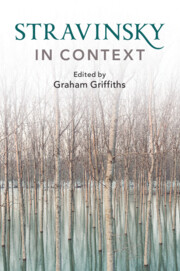Book contents
- Stravinsky in Context
- Composers in Context
- Stravinsky in Context
- Copyright page
- Contents
- Illustrations
- Contributors
- Preface
- Abbreviations
- Frontispiece
- Epigraph
- Part I Russia and Identity
- Part II Stravinsky and Europe
- Part III Partnerships and Authorship
- Part IV Performance and Performers
- Chapter 17 Challenges to Realism and Tradition: Stravinsky’s Modernist Theatre
- Chapter 18 Igor Stravinsky and Ballet as Modernism
- Chapter 19 Stravinsky’s Ear for Instruments
- Chapter 20 Towards a Conductor-Proof Ideal
- Chapter 21 The Pianist in the Recording Studio: Reimagining Interpretation
- Chapter 22 The Legacy of Stravinsky as Recorded History
- Part V Aesthetics and Politics
- Part VI Reception and Legacy
- Recommendations for Further Reading and Research
- Index
- Endmatter
Chapter 17 - Challenges to Realism and Tradition: Stravinsky’s Modernist Theatre
from Part IV - Performance and Performers
Published online by Cambridge University Press: 03 December 2020
- Stravinsky in Context
- Composers in Context
- Stravinsky in Context
- Copyright page
- Contents
- Illustrations
- Contributors
- Preface
- Abbreviations
- Frontispiece
- Epigraph
- Part I Russia and Identity
- Part II Stravinsky and Europe
- Part III Partnerships and Authorship
- Part IV Performance and Performers
- Chapter 17 Challenges to Realism and Tradition: Stravinsky’s Modernist Theatre
- Chapter 18 Igor Stravinsky and Ballet as Modernism
- Chapter 19 Stravinsky’s Ear for Instruments
- Chapter 20 Towards a Conductor-Proof Ideal
- Chapter 21 The Pianist in the Recording Studio: Reimagining Interpretation
- Chapter 22 The Legacy of Stravinsky as Recorded History
- Part V Aesthetics and Politics
- Part VI Reception and Legacy
- Recommendations for Further Reading and Research
- Index
- Endmatter
Summary
Classifying Stravinsky’s rich diversity of stage works is no easy matter. Each composition appears to be a unique, sui generis experiment – an impression conveyed by the sheer variety of ways in which music, words and gesture are combined, contrasted and juxtaposed. To which genre do they belong, apart from those obviously classifiable as ballets? The operatic and music theatre works present quite a challenge in this regard. Stravinsky’s subtitles often allude to past theatrical conventions, but these only further highlight the diversity of genre, indeed their very uniqueness. For example, ‘opera-oratorio’ – the label tied to Oedipus rex – refers to its frequent allusions to both nineteenth-century Italian opera and Baroque oratorio; and Perséphone’s subtitle mélodrame clearly refers to this eighteenth- and nineteenth-century genre where a spoken, not sung text is accompanied by and intercalated with instrumental music. However, these labels only have the function of recalling an ideal model and cannot be considered as true genre definitions such as might usefully be applied to an entire set of works. When considered as a whole, in fact, Stravinsky’s operatic/music theatre output is not based on any single consolidated or stable system of genres. Rather, it is as if Stravinsky is working to a more general aesthetic principle by which he considers the artistic means of the work, that is, its words, gestures and music to be autonomous and capable of being combined in a different way in each work.
- Type
- Chapter
- Information
- Stravinsky in Context , pp. 153 - 161Publisher: Cambridge University PressPrint publication year: 2020

